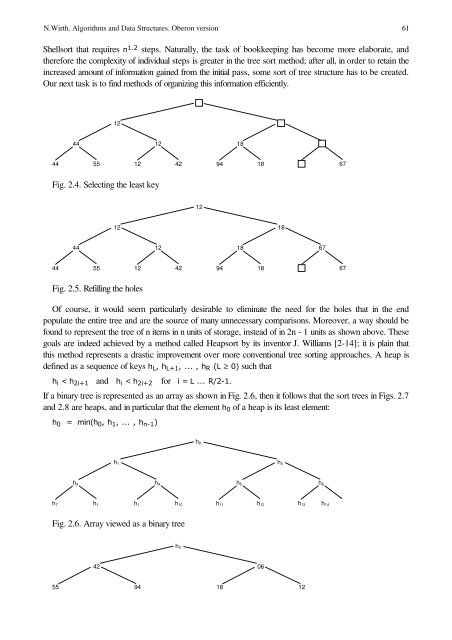Algorithms and Data Structures
Algorithms and Data Structures
Algorithms and Data Structures
Create successful ePaper yourself
Turn your PDF publications into a flip-book with our unique Google optimized e-Paper software.
N.Wirth. <strong>Algorithms</strong> <strong>and</strong> <strong>Data</strong> <strong>Structures</strong>. Oberon version 61<br />
Shellsort that requires n 1.2 steps. Naturally, the task of bookkeeping has become more elaborate, <strong>and</strong><br />
therefore the complexity of individual steps is greater in the tree sort method; after all, in order to retain the<br />
increased amount of information gained from the initial pass, some sort of tree structure has to be created.<br />
Our next task is to find methods of organizing this information efficiently.<br />
12<br />
44<br />
12<br />
18<br />
44<br />
55<br />
12<br />
42<br />
94 18<br />
67<br />
Fig. 2.4. Selecting the least key<br />
12<br />
12<br />
18<br />
44<br />
12<br />
18<br />
67<br />
44<br />
55<br />
12<br />
42<br />
94<br />
18<br />
67<br />
Fig. 2.5. Refilling the holes<br />
Of course, it would seem particularly desirable to eliminate the need for the holes that in the end<br />
populate the entire tree <strong>and</strong> are the source of many unnecessary comparisons. Moreover, a way should be<br />
found to represent the tree of n items in n units of storage, instead of in 2n - 1 units as shown above. These<br />
goals are indeed achieved by a method called Heapsort by its inventor J. Williams [2-14]; it is plain that<br />
this method represents a drastic improvement over more conventional tree sorting approaches. A heap is<br />
defined as a sequence of keys h L , h L+1 , ... , h R (L ≥ 0) such that<br />
h i < h 2i+1 <strong>and</strong> h i < h 2i+2 for i = L ... R/2-1.<br />
If a binary tree is represented as an array as shown in Fig. 2.6, then it follows that the sort trees in Figs. 2.7<br />
<strong>and</strong> 2.8 are heaps, <strong>and</strong> in particular that the element h 0 of a heap is its least element:<br />
h 0 = min(h 0 , h 1 , ... , h n-1 )<br />
h 0<br />
h 1<br />
h 2<br />
h 3<br />
h 4<br />
h 5<br />
h 6<br />
h 7<br />
h 8<br />
h 9<br />
h 10<br />
h 11<br />
h 12<br />
h 13<br />
h 14<br />
Fig. 2.6. Array viewed as a binary tree<br />
h 0<br />
42<br />
06<br />
55 94<br />
18 12
















